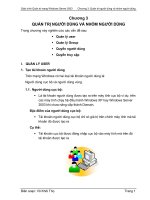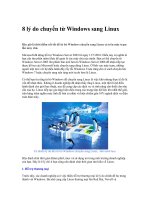Tài liệu Technical Overview of Clustering in Windows Server 2003 pdf
Bạn đang xem bản rút gọn của tài liệu. Xem và tải ngay bản đầy đủ của tài liệu tại đây (164.99 KB, 23 trang )
Technical Overview of Clustering in Windows Server 2003
Microsoft Corporation
Published: January 2003
Abstract
This white paper summarizes the new clustering features available in Microsoft
®
Windows
®
Server 2003.
Microsoft® Windows® Server 2003 Technical Article
The information contained in this document represents the current view of
Microsoft Corporation on the issues discussed as of the date of publication.
Because Microsoft must respond to changing market conditions, it should not be
interpreted to be a commitment on the part of Microsoft, and Microsoft cannot
guarantee the accuracy of any information presented after the date of publication.
This document is for informational purposes only. MICROSOFT MAKES NO
WARRANTIES, EXPRESS OR IMPLIED, AS TO THE INFORMATION IN THIS
DOCUMENT.
Complying with all applicable copyright laws is the responsibility of the user.
Without limiting the rights under copyright, no part of this document may be
reproduced, stored in or introduced into a retrieval system, or transmitted in any
form or by any means (electronic, mechanical, photocopying, recording, or
otherwise), or for any purpose, without the express written permission of Microsoft
Corporation.
Microsoft may have patents, patent applications, trademarks, copyrights, or other
intellectual property rights covering subject matter in this document. Except as
expressly provided in any written license agreement from Microsoft, the furnishing
of this document does not give you any license to these patents, trademarks,
copyrights, or other intellectual property.
© 2002. Microsoft Corporation. All rights reserved. Microsoft, Active Directory,
Windows, and Windows NT are either registered trademarks or trademarks of
Microsoft Corporation in the United States and/or other countries.
The names of actual companies and products mentioned herein may be the
trademarks of their respective owners.
Technical Overview of Clustering in Windows Server 2003 ii
Microsoft® Windows® Server 2003 Technical Article
Contents
Contents........................................................................................................................................ iii
Server Clusters.............................................................................................................................. 7
Server Clusters.............................................................................................................................. 7
General........................................................................................................................................ 7
General........................................................................................................................................ 7
Larger Cluster Sizes................................................................................................................ 7
64-Bit Support......................................................................................................................... 7
Terminal Server Application Mode........................................................................................... 7
Majority Node Set (MNS) Clusters........................................................................................... 8
Installation.................................................................................................................................... 8
Installation.................................................................................................................................... 8
Installed by Default.................................................................................................................. 8
Pre-configuration Analysis.......................................................................................................9
Default Values......................................................................................................................... 9
Multi Node Addition................................................................................................................. 9
Extensible Architecture............................................................................................................ 9
Remote Administration............................................................................................................ 9
Command Line Tools............................................................................................................. 10
Simpler Uninstallation............................................................................................................ 10
Quorum Log Size................................................................................................................... 10
Local Quorum........................................................................................................................ 10
Quorum Selection.................................................................................................................. 11
Integration.................................................................................................................................. 11
Integration.................................................................................................................................. 11
What’s New in Clustering for Windows Server 2003 iii
Microsoft® Windows® Server 2003 Technical Article
Active Directory..................................................................................................................... 11
Extend Cluster Shared Disk Partitions ..................................................................................12
Resources.................................................................................................................................. 12
Resources.................................................................................................................................. 12
Printer Configuration ............................................................................................................. 12
MSDTC Configuration............................................................................................................ 12
Scripting................................................................................................................................ 13
MSMQ Triggers..................................................................................................................... 13
Network Enhancements.............................................................................................................13
Network Enhancements.............................................................................................................13
Enhanced Network Failover .................................................................................................. 13
Media Sense Detection.......................................................................................................... 14
Multicast Heartbeat................................................................................................................ 14
Storage...................................................................................................................................... 14
Storage...................................................................................................................................... 14
Volume Mount Points............................................................................................................. 14
Client Side Caching (CSC)....................................................................................................15
Distributed File System.......................................................................................................... 15
Encrypted File System........................................................................................................... 15
Storage Area Networks (SAN)...............................................................................................15
Operations................................................................................................................................. 16
Operations................................................................................................................................. 16
Backup and Restore.............................................................................................................. 16
Enhanced Node Failover....................................................................................................... 16
What’s New in Clustering for Windows Server 2003 iv
Microsoft® Windows® Server 2003 Technical Article
Group Affinity Support .......................................................................................................... 16
Node Eviction........................................................................................................................ 17
Rolling Upgrades................................................................................................................... 17
Queued Changes.................................................................................................................. 17
Disk Changes........................................................................................................................ 17
Password Change................................................................................................................. 18
Resource Deletion................................................................................................................. 18
WMI Support ........................................................................................................................ 18
Supporting and Troubleshooting................................................................................................. 19
Supporting and Troubleshooting................................................................................................. 19
Offline/Failure Reason Codes ............................................................................................... 19
Software Tracing................................................................................................................... 19
Cluster Logs.......................................................................................................................... 19
Event Log.............................................................................................................................. 19
Clusdiag................................................................................................................................ 20
Chkdsk Log........................................................................................................................... 20
Disk Corruption...................................................................................................................... 20
Network Load Balancing............................................................................................................. 21
Network Load Balancing............................................................................................................. 21
Network Load Balancing Manager.............................................................................................. 21
Network Load Balancing Manager.............................................................................................. 21
Virtual Clusters........................................................................................................................... 21
Virtual Clusters........................................................................................................................... 21
Multi-NIC support....................................................................................................................... 22
Multi-NIC support....................................................................................................................... 22
Bi-directional Affinity................................................................................................................... 22
What’s New in Clustering for Windows Server 2003 v
Microsoft® Windows® Server 2003 Technical Article
Bi-directional Affinity................................................................................................................... 22
Limiting switch flooding using IGMP support..............................................................................23
Limiting switch flooding using IGMP support..............................................................................23
What’s New in Clustering for Windows Server 2003 vi
Microsoft® Windows® Server 2003 Technical Article
Server Clusters
NOTE: Server clusters is a general term used to describe clusters based on the Microsoft
®
Cluster
Service (MSCS), as opposed to clusters based on Network Load Balancing.
General
Larger Cluster Sizes
Microsoft Windows
®
Server 2003 Enterprise Edition now supports 8-node clusters (was two), and
Windows Server 2003 Datacenter Edition now supports 8-node clusters (was four).
Benefits
• Greater Flexibility – this provides much more flexibility in how applications can be deployed
on a Server cluster. Applications that support multiple instances can run more instances
across more nodes; multiple applications can be deployed on a single Server cluster with
much more flexibility and control over the semantics if/when a node fails or is taken down
for maintenance.
64-Bit Support
The 64-bit versions of Windows Server 2003 Enterprise Edition and Datacenter Edition support Cluster
Service.
Benefits
• Large Memory Needs – Microsoft SQL Server™ 2000 Enterprise Edition (64-bit) is one
example of an application that can make use of the increased memory space of 64-bit
Windows Server 2003 (up to 4TB – Windows 2000 Datacenter only supports up to 64GB),
while at the same time taking advantage of clustering. This provides an incredibly powerful
platform for the most computer intensive applications, while ensuring high availability of
those applications.
NOTE: GUID Partition Table (GPT) disks, a new disk architecture in Windows Server 2003 that
supports up to 18 exabyte disks, is not supported with Server clusters.
Terminal Server Application Mode
Terminal Server can run in application mode on nodes in a Server cluster. NOTE: There is no failover of
Terminal Server sessions.
Benefits
• High Availability - Terminal Server directory service can be made highly available through
failover.
What’s New in Clustering for Windows Server 2003 7
Microsoft® Windows® Server 2003 Technical Article
Majority Node Set (MNS) Clusters
Windows Server 2003 has an optional quorum resource that does not require a disk on a shared bus for
the quorum device. This feature is designed to be built in to larger end-to-end solutions by OEMs, IHVs
and other software vendors rather than be deployed by end-users specifically, although this is possible
for experienced users. The scenarios targeted by this new feature include:
• Geographically dispersed clusters. This mechanism provides a single, Microsoft-supplied
quorum resource that is independent of any storage solution for a geographically dispersed
or multi-site cluster. NOTE: There is a separate cluster Hardware Compatibility List (HCL)
for geographic clusters.
• Low-cost or appliance-like highly available solutions that have no shared disks but use
other techniques such as log shipping or software disk or file system replication and
mirroring to make data available on multiple nodes in the cluster.
NOTE: Windows Server 2003 provides no mechanism to mirror or replicate user data across the nodes
of an MNS cluster, so while it is possible to build clusters with no shared disks at all, it is an application
specific issue to make the application data highly available and redundant across machines.
Benefits
• Storage Abstraction – frees up the storage subsystem to manage data replication between
multiple sites in the most appropriate way, without having to worry about a shared quorum
disk, and at the same time still supporting the idea of a single virtual cluster.
• No Shared Disks – there are some scenarios that require tightly consistent cluster features,
yet do not require shared disks. For example, a) clusters where the application keeps data
consistent between nodes (e.g. database log shipping and file replication for relatively
static data), and b) clusters that host applications that have no persistent data, but need to
cooperate in a tightly coupled way to provide consistent volatile state.
• Enhanced Redundancy – if the shared quorum disk is corrupted in any way, the entire
cluster goes offline. With Majority Node Sets, the corruption of quorum on one node does
not bring the entire cluster offline.
Installation
Installed by Default
Clustering is installed by default. You only need to configure a Cluster by launching Cluster
Administrator or script the configuration with Cluster.exe. In addition, third-party quorum resources can
be pre-installed and then selected during Server cluster configuration, rather than having additional
resource specific procedures. All Server cluster configurations can be deployed the same way.
Benefits
• Easier Administration – you no longer need to provide a media CD to install Server
clusters.
What’s New in Clustering for Windows Server 2003 8
Microsoft® Windows® Server 2003 Technical Article
• No reboot – you no longer need to reboot after you install or uninstall Cluster Service.
Pre-configuration Analysis
Analyzes and verifies hardware and software configuration and identifies potential problems. Provides a
comprehensive and easy-to-read report on any potential configuration issues before the Server cluster
is created.
Benefits
• Compatability – Ensures that any known incompatibilities are detected prior to
configuration. For example, Service for Macintosh (SFM), Network Load Balancing (NLB),
dynamic disks, and DHCP issued addresses are not supported with Cluster Service.
Default Values
Creates a Server cluster that conforms to best practices using default values and heuristics. Many times
for newly created Server clusters, the default values are the most appropriate configuration.
Benefits
• Easier Administration – Server cluster creation asks fewer setup questions, data is
collected and the code makes decisions about the configuration. The goal is to get a
“default” Server cluster up and running that can then be customized using the Server
cluster administration tools if required.
Multi Node Addition
Allows multiple nodes to be added to a Server cluster in a single operation.
Benefits
• Easier Administration – makes it quicker and easier to create multi-node Server clusters.
Extensible Architecture
Extensible architecture allows applications and system components to take part in Server cluster
configuration. For example, applications can be installed prior to a server being server clustered and the
application can participate in (or even block) this node joining the Server cluster.
Benefits
• Third-Party Support – allows applications to setup Server cluster resources and/or change
their configuration as part of Server cluster installations rather than as a separate post-
Server cluster installation task.
Remote Administration
Allows full remote creation and configuration of the Server cluster. New Server clusters can be created
and nodes can be added to an existing Server cluster from a remote management station. In addition,
What’s New in Clustering for Windows Server 2003 9









